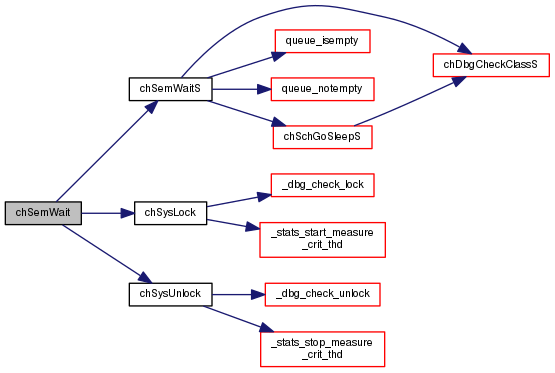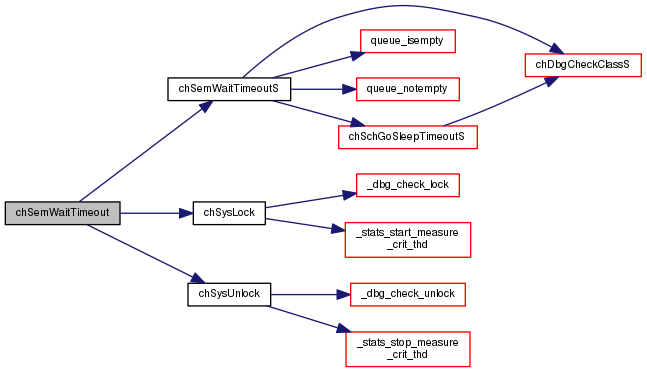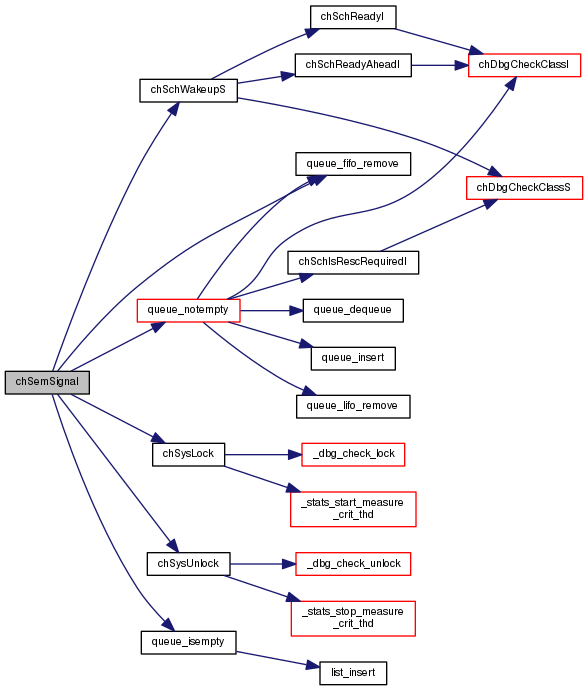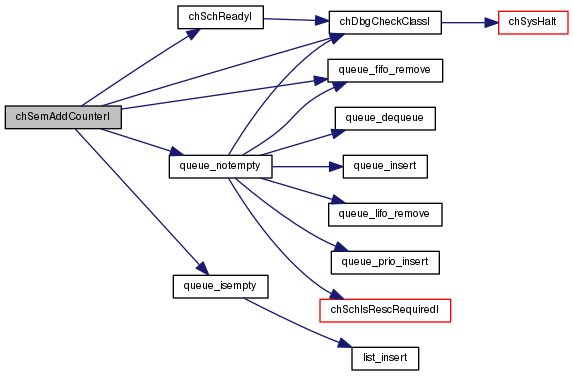
|
Detailed Description
Semaphores related APIs and services.
Operation mode
Semaphores are a flexible synchronization primitive, ChibiOS/RT implements semaphores in their "counting semaphores" variant as defined by Edsger Dijkstra plus several enhancements like:
- Wait operation with timeout.
- Reset operation.
- Atomic wait+signal operation.
- Return message from the wait operation (OK, RESET, TIMEOUT).
The binary semaphores variant can be easily implemented using counting semaphores.
Operations defined for semaphores:
- Signal: The semaphore counter is increased and if the result is non-positive then a waiting thread is removed from the semaphore queue and made ready for execution.
- Wait: The semaphore counter is decreased and if the result becomes negative the thread is queued in the semaphore and suspended.
- Reset: The semaphore counter is reset to a non-negative value and all the threads in the queue are released.
Semaphores can be used as guards for mutual exclusion zones (note that mutexes are recommended for this kind of use) but also have other uses, queues guards and counters for example.
Semaphores usually use a FIFO queuing strategy but it is possible to make them order threads by priority by enabling CH_CFG_USE_SEMAPHORES_PRIORITY in chconf.h.
- Precondition
- In order to use the semaphore APIs the
CH_CFG_USE_SEMAPHORESoption must be enabled inchconf.h.
Macros | |
| #define | _SEMAPHORE_DATA(name, n) {_THREADS_QUEUE_DATA(name.queue), n} |
| Data part of a static semaphore initializer. More... | |
| #define | SEMAPHORE_DECL(name, n) semaphore_t name = _SEMAPHORE_DATA(name, n) |
| Static semaphore initializer. More... | |
Typedefs | |
| typedef struct ch_semaphore | semaphore_t |
| Semaphore structure. More... | |
Data Structures | |
| struct | ch_semaphore |
| Semaphore structure. More... | |
Functions | |
| void | chSemObjectInit (semaphore_t *sp, cnt_t n) |
| Initializes a semaphore with the specified counter value. More... | |
| void | chSemReset (semaphore_t *sp, cnt_t n) |
| Performs a reset operation on the semaphore. More... | |
| void | chSemResetI (semaphore_t *sp, cnt_t n) |
| Performs a reset operation on the semaphore. More... | |
| msg_t | chSemWait (semaphore_t *sp) |
| Performs a wait operation on a semaphore. More... | |
| msg_t | chSemWaitS (semaphore_t *sp) |
| Performs a wait operation on a semaphore. More... | |
| msg_t | chSemWaitTimeout (semaphore_t *sp, sysinterval_t timeout) |
| Performs a wait operation on a semaphore with timeout specification. More... | |
| msg_t | chSemWaitTimeoutS (semaphore_t *sp, sysinterval_t timeout) |
| Performs a wait operation on a semaphore with timeout specification. More... | |
| void | chSemSignal (semaphore_t *sp) |
| Performs a signal operation on a semaphore. More... | |
| void | chSemSignalI (semaphore_t *sp) |
| Performs a signal operation on a semaphore. More... | |
| void | chSemAddCounterI (semaphore_t *sp, cnt_t n) |
| Adds the specified value to the semaphore counter. More... | |
| msg_t | chSemSignalWait (semaphore_t *sps, semaphore_t *spw) |
| Performs atomic signal and wait operations on two semaphores. More... | |
| static void | chSemFastWaitI (semaphore_t *sp) |
| Decreases the semaphore counter. More... | |
| static void | chSemFastSignalI (semaphore_t *sp) |
| Increases the semaphore counter. More... | |
| static cnt_t | chSemGetCounterI (const semaphore_t *sp) |
| Returns the semaphore counter current value. More... | |
Macro Definition Documentation
| #define _SEMAPHORE_DATA | ( | name, | |
| n | |||
| ) | {_THREADS_QUEUE_DATA(name.queue), n} |
Data part of a static semaphore initializer.
This macro should be used when statically initializing a semaphore that is part of a bigger structure.
- Parameters
-
[in] name the name of the semaphore variable [in] n the counter initial value, this value must be non-negative
| #define SEMAPHORE_DECL | ( | name, | |
| n | |||
| ) | semaphore_t name = _SEMAPHORE_DATA(name, n) |
Typedef Documentation
| typedef struct ch_semaphore semaphore_t |
Semaphore structure.
Function Documentation
| void chSemObjectInit | ( | semaphore_t * | sp, |
| cnt_t | n | ||
| ) |
Initializes a semaphore with the specified counter value.
- Parameters
-
[out] sp pointer to a semaphore_tstructure[in] n initial value of the semaphore counter. Must be non-negative.
- Function Class:
- Initializer, this function just initializes an object and can be invoked before the kernel is initialized.
Definition at line 97 of file chsem.c.
References chDbgCheck, ch_semaphore::cnt, ch_semaphore::queue, and queue_init().
Referenced by _factory_init(), _heap_init(), chBSemObjectInit(), chFactoryCreateSemaphore(), chGuardedPoolObjectInitAligned(), and chHeapObjectInit().

| void chSemReset | ( | semaphore_t * | sp, |
| cnt_t | n | ||
| ) |
Performs a reset operation on the semaphore.
- Postcondition
- After invoking this function all the threads waiting on the semaphore, if any, are released and the semaphore counter is set to the specified, non negative, value.
- Note
- The released threads can recognize they were waked up by a reset rather than a signal because the
chSemWait()will returnMSG_RESETinstead ofMSG_OK.
- Parameters
-
[in] sp pointer to a semaphore_tstructure[in] n the new value of the semaphore counter. The value must be non-negative.
- Function Class:
- Normal API, this function can be invoked by regular system threads but not from within a lock zone.
Definition at line 120 of file chsem.c.
References chSchRescheduleS(), chSemResetI(), chSysLock(), and chSysUnlock().
Referenced by chBSemReset().

| void chSemResetI | ( | semaphore_t * | sp, |
| cnt_t | n | ||
| ) |
Performs a reset operation on the semaphore.
- Postcondition
- After invoking this function all the threads waiting on the semaphore, if any, are released and the semaphore counter is set to the specified, non negative, value.
- This function does not reschedule so a call to a rescheduling function must be performed before unlocking the kernel. Note that interrupt handlers always reschedule on exit so an explicit reschedule must not be performed in ISRs.
- Note
- The released threads can recognize they were waked up by a reset rather than a signal because the
chSemWait()will returnMSG_RESETinstead ofMSG_OK.
- Parameters
-
[in] sp pointer to a semaphore_tstructure[in] n the new value of the semaphore counter. The value must be non-negative.
- Function Class:
- This is an I-Class API, this function can be invoked from within a system lock zone by both threads and interrupt handlers.
Definition at line 147 of file chsem.c.
References chDbgAssert, chDbgCheck, chDbgCheckClassI(), chSchReadyI(), ch_semaphore::cnt, MSG_RESET, ch_semaphore::queue, queue_isempty(), queue_lifo_remove(), queue_notempty(), ch_thread::rdymsg, and ch_thread::u.
Referenced by chBSemResetI(), and chSemReset().

| msg_t chSemWait | ( | semaphore_t * | sp | ) |
Performs a wait operation on a semaphore.
- Parameters
-
[in] sp pointer to a semaphore_tstructure
- Returns
- A message specifying how the invoking thread has been released from the semaphore.
- Return values
-
MSG_OK if the thread has not stopped on the semaphore or the semaphore has been signaled. MSG_RESET if the semaphore has been reset using chSemReset().
- Function Class:
- Normal API, this function can be invoked by regular system threads but not from within a lock zone.
Definition at line 175 of file chsem.c.
References chSemWaitS(), chSysLock(), and chSysUnlock().
Referenced by chBSemWait().

| msg_t chSemWaitS | ( | semaphore_t * | sp | ) |
Performs a wait operation on a semaphore.
- Parameters
-
[in] sp pointer to a semaphore_tstructure
- Returns
- A message specifying how the invoking thread has been released from the semaphore.
- Return values
-
MSG_OK if the thread has not stopped on the semaphore or the semaphore has been signaled. MSG_RESET if the semaphore has been reset using chSemReset().
- Function Class:
- This is an S-Class API, this function can be invoked from within a system lock zone by threads only.
Definition at line 197 of file chsem.c.
References CH_STATE_WTSEM, chDbgAssert, chDbgCheck, chDbgCheckClassS(), chSchGoSleepS(), ch_semaphore::cnt, currp, MSG_OK, ch_semaphore::queue, queue_isempty(), and queue_notempty().
Referenced by chBSemWaitS(), and chSemWait().

| msg_t chSemWaitTimeout | ( | semaphore_t * | sp, |
| sysinterval_t | timeout | ||
| ) |
Performs a wait operation on a semaphore with timeout specification.
- Parameters
-
[in] sp pointer to a semaphore_tstructure[in] timeout the number of ticks before the operation timeouts, the following special values are allowed: - TIME_IMMEDIATE immediate timeout.
- TIME_INFINITE no timeout.
- Returns
- A message specifying how the invoking thread has been released from the semaphore.
- Return values
-
MSG_OK if the thread has not stopped on the semaphore or the semaphore has been signaled. MSG_RESET if the semaphore has been reset using chSemReset().MSG_TIMEOUT if the semaphore has not been signaled or reset within the specified timeout.
- Function Class:
- Normal API, this function can be invoked by regular system threads but not from within a lock zone.
Definition at line 235 of file chsem.c.
References chSemWaitTimeoutS(), chSysLock(), and chSysUnlock().
Referenced by chBSemWaitTimeout().

| msg_t chSemWaitTimeoutS | ( | semaphore_t * | sp, |
| sysinterval_t | timeout | ||
| ) |
Performs a wait operation on a semaphore with timeout specification.
- Parameters
-
[in] sp pointer to a semaphore_tstructure[in] timeout the number of ticks before the operation timeouts, the following special values are allowed: - TIME_IMMEDIATE immediate timeout.
- TIME_INFINITE no timeout.
- Returns
- A message specifying how the invoking thread has been released from the semaphore.
- Return values
-
MSG_OK if the thread has not stopped on the semaphore or the semaphore has been signaled. MSG_RESET if the semaphore has been reset using chSemReset().MSG_TIMEOUT if the semaphore has not been signaled or reset within the specified timeout.
- Function Class:
- This is an S-Class API, this function can be invoked from within a system lock zone by threads only.
Definition at line 264 of file chsem.c.
References CH_STATE_WTSEM, chDbgAssert, chDbgCheck, chDbgCheckClassS(), chSchGoSleepTimeoutS(), ch_semaphore::cnt, currp, MSG_OK, MSG_TIMEOUT, ch_semaphore::queue, queue_isempty(), queue_notempty(), and TIME_IMMEDIATE.
Referenced by chBSemWaitTimeoutS(), chGuardedPoolAllocTimeoutS(), and chSemWaitTimeout().

| void chSemSignal | ( | semaphore_t * | sp | ) |
Performs a signal operation on a semaphore.
- Parameters
-
[in] sp pointer to a semaphore_tstructure
- Function Class:
- Normal API, this function can be invoked by regular system threads but not from within a lock zone.
Definition at line 294 of file chsem.c.
References chDbgAssert, chDbgCheck, chSchWakeupS(), chSysLock(), chSysUnlock(), ch_semaphore::cnt, MSG_OK, ch_semaphore::queue, queue_fifo_remove(), queue_isempty(), and queue_notempty().

| void chSemSignalI | ( | semaphore_t * | sp | ) |
Performs a signal operation on a semaphore.
- Postcondition
- This function does not reschedule so a call to a rescheduling function must be performed before unlocking the kernel. Note that interrupt handlers always reschedule on exit so an explicit reschedule must not be performed in ISRs.
- Parameters
-
[in] sp pointer to a semaphore_tstructure
- Function Class:
- This is an I-Class API, this function can be invoked from within a system lock zone by both threads and interrupt handlers.
Definition at line 319 of file chsem.c.
References chDbgAssert, chDbgCheck, chDbgCheckClassI(), chSchReadyI(), ch_semaphore::cnt, MSG_OK, ch_semaphore::queue, queue_fifo_remove(), queue_isempty(), queue_notempty(), ch_thread::rdymsg, and ch_thread::u.
Referenced by chBSemSignalI(), and chGuardedPoolFreeI().

| void chSemAddCounterI | ( | semaphore_t * | sp, |
| cnt_t | n | ||
| ) |
Adds the specified value to the semaphore counter.
- Postcondition
- This function does not reschedule so a call to a rescheduling function must be performed before unlocking the kernel. Note that interrupt handlers always reschedule on exit so an explicit reschedule must not be performed in ISRs.
- Parameters
-
[in] sp pointer to a semaphore_tstructure[in] n value to be added to the semaphore counter. The value must be positive.
- Function Class:
- This is an I-Class API, this function can be invoked from within a system lock zone by both threads and interrupt handlers.
Definition at line 349 of file chsem.c.
References chDbgAssert, chDbgCheck, chDbgCheckClassI(), chSchReadyI(), ch_semaphore::cnt, MSG_OK, ch_semaphore::queue, queue_fifo_remove(), queue_isempty(), queue_notempty(), ch_thread::rdymsg, and ch_thread::u.

| msg_t chSemSignalWait | ( | semaphore_t * | sps, |
| semaphore_t * | spw | ||
| ) |
Performs atomic signal and wait operations on two semaphores.
- Parameters
-
[in] sps pointer to a semaphore_tstructure to be signaled[in] spw pointer to a semaphore_tstructure to wait on
- Returns
- A message specifying how the invoking thread has been released from the semaphore.
- Return values
-
MSG_OK if the thread has not stopped on the semaphore or the semaphore has been signaled. MSG_RESET if the semaphore has been reset using chSemReset().
- Function Class:
- Normal API, this function can be invoked by regular system threads but not from within a lock zone.
Definition at line 378 of file chsem.c.
References CH_STATE_WTSEM, chDbgAssert, chDbgCheck, chSchGoSleepS(), chSchReadyI(), chSchRescheduleS(), chSysLock(), chSysUnlock(), ch_semaphore::cnt, currp, MSG_OK, ch_semaphore::queue, queue_fifo_remove(), queue_isempty(), queue_notempty(), ch_thread::rdymsg, ch_thread::u, and ch_thread::wtsemp.

|
inlinestatic |
Decreases the semaphore counter.
This macro can be used when the counter is known to be positive.
- Parameters
-
[in] sp pointer to a semaphore_tstructure
- Function Class:
- This is an I-Class API, this function can be invoked from within a system lock zone by both threads and interrupt handlers.
Definition at line 118 of file chsem.h.
References chDbgCheckClassI(), and ch_semaphore::cnt.
Referenced by chGuardedPoolAllocI().

|
inlinestatic |
Increases the semaphore counter.
This macro can be used when the counter is known to be not negative.
- Parameters
-
[in] sp pointer to a semaphore_tstructure
- Function Class:
- This is an I-Class API, this function can be invoked from within a system lock zone by both threads and interrupt handlers.
Definition at line 134 of file chsem.h.
References chDbgCheckClassI(), and ch_semaphore::cnt.
Referenced by chSchGoSleepS().

|
inlinestatic |
Returns the semaphore counter current value.
- Parameters
-
[in] sp pointer to a semaphore_tstructure
- Returns
- The semaphore counter value.
- Function Class:
- This is an I-Class API, this function can be invoked from within a system lock zone by both threads and interrupt handlers.
Definition at line 149 of file chsem.h.
References chDbgCheckClassI(), and ch_semaphore::cnt.
Referenced by chGuardedPoolAllocI(), and chGuardedPoolGetCounterI().

